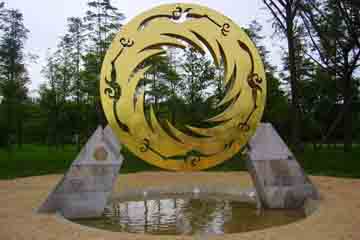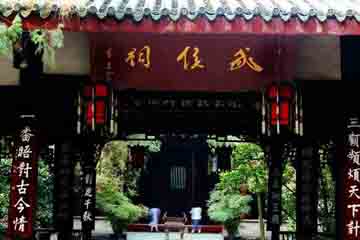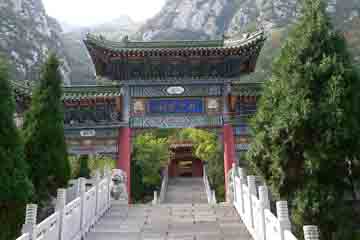Home > Attractions >
Chengdu City Sightseeing
Jinsha Site Museum
Introduction of the museum Jinsha Relics Museum is located in the northwest of Chengdu, about 5 km from downtown district. As a theme park-style museum, it is for the protection of, research into and display of Jinsha relics and archaeological finds. The museum covers 300,000 square meters with a total construction area of approximately 35,000 square meters. It is mainly made up of departments of Relics and Exhibitions and the conservation center. The rest vast areas are for green spaces of thriving trees which really make the museum beautiful and charming. Within the museum park are such leisure and cultural landscapes as Jade Road and Ebony Forest and the like. It is also equipped with complete facilities for the various services. Therefore, you will be feeling refreshed while touring around. Jinsha Relics is the first major archaeological discovery in China in the new millennium and was rated the key reservation unit of the nation
Traffic: Take Bus No, 78,81
Address: 2# Jinsha Site Rd
Admission Fee: 80RMB/PAX
Open Hours:08:00am-06:00pm
Dufu's Thatched Cottage
The Thatched Cottage of Du Fu is located at the side of the Flower Washing Brook in the western suburbs of Chengdu. The cottage is the former residence of the famous Tang Dynasty poet, Du Fu. In the year 759 A.D., at the age of 47, compelled by poverty and social upheaval, he moved from Gansu to the outskirts of Chengdu and built a thatched hut. During his stay of nearly four years, he composed more than 240 poems reflecting upon the misery of the people. The original residence disappeared long ago. It was renovated in the Ming and Qing dynasties and enlarged to its present scale in an expansive park, including a bamboo garden, several pavilions, and a number of bridges
Traffic: Bus No 17, 35, 301
Address: West Caotang Rd
Admission Fee: 60RMB/PAX
Open Hours:08:00am-06:00pm
Wenshu Temple
The Wenshu Temple is a famous Buddhist temple located in the northwest of Chengdu. Its predecessor was the Tang Dynasty Miaoyuan Pagoda Temple, which was renamed “Xinxiang Temple” in the Song Dynasty. Later it was destroyed in war. It is said in the Qing Dynasty red light was reported to have appeared at the place. The government officers then assigned personnel to find out about it. And it was discovered that the image of Bodhisattva Manjusri (Wen Shu) appeared in the red light. So in the 36th year of Emperor Kangxi’s reign (1697), fund was raised to rebuild the temple, which has been since then named the Wenshu Temple. There were two Chinese characters “Kong Lin” (empty forest) autographed by Emperor Kangxi, together with an imperial seal inscribed with “Konglin Chici (Kong Lin bestowed by the Emperor)”. Emperor Kangxi’s writing is still kept in the temple
Traffic: Bus No 16, 55, 64
Address: 15# Wenshuyuan Street
Admission Fee: 5RMB/PAX
Open Hours:08:00am-06:00pm
Wuhouci Museum
Chengdu Wuhouci Museum is the world-famous holy land of Three Kingdoms culture. It is the most reputed memorial site for Zhu Geliang and Liu Bei with unique joint-sacrifice temple in Chengdu, also the largest museum of Three Kingdoms relic in the highest position in China. This temple, built since AD 223, is mainly composed of Huiling, Hanzhaolie temple and Temple of Marquis Wu, in which there are luxuriant ancient cypresses, and quiet ambience and grandiose palaces, belonging to the first to be conserved in the country
Traffic: Bus No 1,8,10,53,57,213,301
Address: 231# Wuhouci Ave
Admission Fee: 60RMB/PAX
Open Hours:08:00am-06:00pm
River-viewing Pavilion
The River Viewing Pavilion Park is not only renowned for its natural beauty; it is also a historically significant place. The highlight of the park is its forests boasting of 100 varieties of bamboo. You will be enthralled as you walk beside the yellow columns of bamboo; you can also hear the exquisite sound when the green leaves sway with the wind. And if you are tired of walking, you can always take rest under the wonderful shade created by the green leaves of the bamboo trees. All the bamboo trees overlook the calm and serene Jin River that was once considered to be the symbol of Chengdu
Traffic: Bus No 3,18,19,31
Address: 30# Wangjiang Rd
Admission Fee: Free
Open Hours:08:00am-06:00pm
Intangible Culture Heritage Park
International Intangible Cultural Heritage Park is your best choice to visit for understanding the traditional and profound intangible cultural heritage, experiencing the diversified intangible cultural heritage and enjoying the glamour of the muti-culture
Traffic: Bus No 54,100,111,342,901
Address: in Lianghe City Forest Park
Admission Fee: Free
Open Hours:08:00am-06:00pm
Introduction of the museum Jinsha Relics Museum is located in the northwest of Chengdu, about 5 km from downtown district. As a theme park-style museum, it is for the protection of, research into and display of Jinsha relics and archaeological finds. The museum covers 300,000 square meters with a total construction area of approximately 35,000 square meters. It is mainly made up of departments of Relics and Exhibitions and the conservation center. The rest vast areas are for green spaces of thriving trees which really make the museum beautiful and charming. Within the museum park are such leisure and cultural landscapes as Jade Road and Ebony Forest and the like. It is also equipped with complete facilities for the various services. Therefore, you will be feeling refreshed while touring around. Jinsha Relics is the first major archaeological discovery in China in the new millennium and was rated the key reservation unit of the nation
Traffic: Take Bus No, 78,81
Address: 2# Jinsha Site Rd
Admission Fee: 80RMB/PAX
Open Hours:08:00am-06:00pm
Dufu's Thatched Cottage
The Thatched Cottage of Du Fu is located at the side of the Flower Washing Brook in the western suburbs of Chengdu. The cottage is the former residence of the famous Tang Dynasty poet, Du Fu. In the year 759 A.D., at the age of 47, compelled by poverty and social upheaval, he moved from Gansu to the outskirts of Chengdu and built a thatched hut. During his stay of nearly four years, he composed more than 240 poems reflecting upon the misery of the people. The original residence disappeared long ago. It was renovated in the Ming and Qing dynasties and enlarged to its present scale in an expansive park, including a bamboo garden, several pavilions, and a number of bridges
Traffic: Bus No 17, 35, 301
Address: West Caotang Rd
Admission Fee: 60RMB/PAX
Open Hours:08:00am-06:00pm
Wenshu Temple
The Wenshu Temple is a famous Buddhist temple located in the northwest of Chengdu. Its predecessor was the Tang Dynasty Miaoyuan Pagoda Temple, which was renamed “Xinxiang Temple” in the Song Dynasty. Later it was destroyed in war. It is said in the Qing Dynasty red light was reported to have appeared at the place. The government officers then assigned personnel to find out about it. And it was discovered that the image of Bodhisattva Manjusri (Wen Shu) appeared in the red light. So in the 36th year of Emperor Kangxi’s reign (1697), fund was raised to rebuild the temple, which has been since then named the Wenshu Temple. There were two Chinese characters “Kong Lin” (empty forest) autographed by Emperor Kangxi, together with an imperial seal inscribed with “Konglin Chici (Kong Lin bestowed by the Emperor)”. Emperor Kangxi’s writing is still kept in the temple
Traffic: Bus No 16, 55, 64
Address: 15# Wenshuyuan Street
Admission Fee: 5RMB/PAX
Open Hours:08:00am-06:00pm
Wuhouci Museum
Chengdu Wuhouci Museum is the world-famous holy land of Three Kingdoms culture. It is the most reputed memorial site for Zhu Geliang and Liu Bei with unique joint-sacrifice temple in Chengdu, also the largest museum of Three Kingdoms relic in the highest position in China. This temple, built since AD 223, is mainly composed of Huiling, Hanzhaolie temple and Temple of Marquis Wu, in which there are luxuriant ancient cypresses, and quiet ambience and grandiose palaces, belonging to the first to be conserved in the country
Traffic: Bus No 1,8,10,53,57,213,301
Address: 231# Wuhouci Ave
Admission Fee: 60RMB/PAX
Open Hours:08:00am-06:00pm
River-viewing Pavilion
The River Viewing Pavilion Park is not only renowned for its natural beauty; it is also a historically significant place. The highlight of the park is its forests boasting of 100 varieties of bamboo. You will be enthralled as you walk beside the yellow columns of bamboo; you can also hear the exquisite sound when the green leaves sway with the wind. And if you are tired of walking, you can always take rest under the wonderful shade created by the green leaves of the bamboo trees. All the bamboo trees overlook the calm and serene Jin River that was once considered to be the symbol of Chengdu
Traffic: Bus No 3,18,19,31
Address: 30# Wangjiang Rd
Admission Fee: Free
Open Hours:08:00am-06:00pm
Intangible Culture Heritage Park
International Intangible Cultural Heritage Park is your best choice to visit for understanding the traditional and profound intangible cultural heritage, experiencing the diversified intangible cultural heritage and enjoying the glamour of the muti-culture
Traffic: Bus No 54,100,111,342,901
Address: in Lianghe City Forest Park
Admission Fee: Free
Open Hours:08:00am-06:00pm






